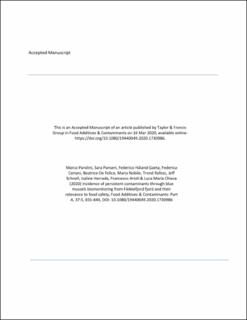| dc.contributor.author | Parolini, Marco | |
| dc.contributor.author | Panseri, Sara | |
| dc.contributor.author | Gaeta, Federico Håland | |
| dc.contributor.author | Ceriani, Federica | |
| dc.contributor.author | De Beatrice, Felice | |
| dc.contributor.author | Nobile, Maria | |
| dc.contributor.author | Rafoss, Trond | |
| dc.contributor.author | Schnell, Jeff | |
| dc.contributor.author | Herrada, Isaline | |
| dc.contributor.author | Arioli, Francesco | |
| dc.contributor.author | Chiesa, Luca Maria | |
| dc.date.accessioned | 2021-05-27T12:40:47Z | |
| dc.date.available | 2021-05-27T12:40:47Z | |
| dc.date.created | 2020-09-06T21:57:53Z | |
| dc.date.issued | 2020 | |
| dc.identifier.citation | Food Additives & Contaminants. 2020, 37 (5), 831-844. | en_US |
| dc.identifier.issn | 1944-0049 | |
| dc.identifier.uri | https://hdl.handle.net/11250/2756685 | |
| dc.description | This is an Accepted Manuscript of an article published by Taylor & Francis
Group in Food Additives & Contaminants on 16 Mar 2020, available online:
https://doi.org/10.1080/19440049.2020.1730986.
Embargo until September 16 2021 | en_US |
| dc.description.abstract | Dredging activities can lead to the re-suspension of contaminated sediments, resulting in a potential hazard for the whole ecosystem and also for human health. Six-month active biomonitoring was performed in order to monitor the trends of different classes of both legacy (organochlorine – OCPs – and organophosphate (OPs) compounds and polychlorinated biphenyls – PCBs) and emerging (polybromodiphenyl ethers – PBDE – and per- and polyfluoroalkyl substances – PFASs) organohalogen compounds, as well as polycyclic aromatic hydrocarbons (PAHs), in blue mussel (Mytilus edulis spp.) specimens transplanted at different depths in the Flekkefjord fjord. Such biomonitoring was performed to evaluate the efficacy of sediment restoration activities and to check for the potential environmental risk for the biota and food safety for human seafood. Negligible contamination by OCPs, OPs, PBDEs and PFASs was noted in mussels over the 6-month biomonitoring, while a notable increase in the concentrations of PCBs and PAHs occurred in mussels transplanted at 15 m depth in three sampling sites within the fjord, as a consequence of an undersea landslide which occurred during restoration activities. Levels of PCBs and PAHs suggested a potential risk for mussel predators and also for the human health, as they exceeded the limit set by the European Commission for the consumption of bivalve molluscs. These results confirm the reliability of active biomonitoring to flank dredging activities aimed at ecosystem restoration in order to monitor the trend of contaminants and to estimate the potential risk for the aquatic communities and human health. | en_US |
| dc.language.iso | eng | en_US |
| dc.publisher | Taylor & Francis | en_US |
| dc.rights | Attribution-NonCommercial-NoDerivatives 4.0 Internasjonal | * |
| dc.rights.uri | http://creativecommons.org/licenses/by-nc-nd/4.0/deed.no | * |
| dc.title | Incidence of persistent contaminants through blue mussels biomonitoring from Flekkefjord fjord and their relevance to food safety | en_US |
| dc.type | Peer reviewed | en_US |
| dc.type | Journal article | en_US |
| dc.description.version | acceptedVersion | en_US |
| dc.source.pagenumber | 831-844 | en_US |
| dc.source.volume | 37 | en_US |
| dc.source.journal | Food Additives & Contaminants | en_US |
| dc.source.issue | 5 | en_US |
| dc.identifier.doi | 10.1080/19440049.2020.1730986 | |
| dc.identifier.cristin | 1827593 | |
| cristin.ispublished | true | |
| cristin.fulltext | postprint | |
| cristin.qualitycode | 1 | |

